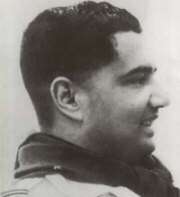Karun Krishna Majumdar
| Karun Krishna Majumdar | |
|---|---|
 Karun Krishna Majumdar | |
| Born |
6 September 1913 Kolkata, Bengal, British India |
| Died |
17 February 1945 (aged 31) Lyallpur, Punjab, British India |
| Allegiance |
|
| Rank | Wing Commander |
| Battles/wars | Pacific War, Second World War |
| Awards | Distinguished Flying Cross and Bar |
Karun Krishna Majumdar (Bengali: করুণকৃষ্ণ মজুমদার) (6 September 1913 - 17 February 1945) was a Wing Commander who took part in the Second World War.
Early life
Karun Krishna Majumdar was born in Kolkata on 6 September 1913.[1] His maternal grandfather was Womesh Chunder Bonnerjee was the first president of the Indian National Congress.[1] He was nicknamed Jumbo. Majumdar attended St. Pauls School in Darjeeling. In 1932, he travelled to England and took admission in Royal Air Force College Cranwell.[1] In 1933, he returned to India as a trained pilot.
Career
Majumdar joined No. 1 Squadron of the Indian Air Force in the 1930s as Flying Officer.[2] Majumdar first flew Westland Wapiti and then Hawker Hart. Soon he was promoted to Flight Commander of the 'C' Flight of No. 1 Squadron. In June 1941, Majumdar was promoted to Squadron Leader and he took charge of No. 1 Squadron in Miramshah. In August 1941, the No. 1 Squadron was upgraded with Westland Lysander aircraft and training commenced in Drigh Road.

In 1942, the Imperial Japanese forces occupied Burma. The No. 1 Squadron of the Royal Indian Air Force was posted to Burma. Majumdar reached Taungoo with forces on 1 February 1942. On the very next day the Imperial Japanese Army Air Force based in Mae Hong Son attacked Taungoo and destroyed the aircraft and the airbase installation of the Allies. However, the No. 1 Squadron remained unharmed. Majumdar immediately planned retaliatory action with Westland Lysander, even though it was not considered a fighter aircraft. Next day he flew solo on a Westland Lysander carrying two 250 pound bombs, towards the Japanese airbase in Mae Hong Son. The New Zealanders of No. 67 Squadron of Royal Air Force send two Buffalo aircraft in support. Majumdar took considerable risk in flying low and dropping bombs accurately on target, destroying the enemy hangar, aircraft and airfield. On the next day, Majumdar led the entire squadron in a bombing mission and destroyed the aircraft, wireless installations and the buildings. Till the fall of Yangon in April 1942, the Westland Lysanders of the No. 1 Squadron played a supporting role for the army. After that Majumdar returned to India and spent the next to years in staff and flying assignments. He was promoted to Wing Commander.
In 1943, Majumdar volunteered for a role in the European War. He arrived in England in March 1944.[3] He resumed his flying duties in June 1944, in a reconnaissance role in the No. 268 Squadron of Royal Air Force. In his first operational flight on 10 June 1944, he made a reconnaissance over Seine River attacking enemy ground targets. His operational tour ended on 20 September. During this period of 100 days Majumdar flew 65 operational sorties in Supermarine Spitfires.[3] He successfully operated vital reconnaissance mission over the Falaise Gap in Normandy. His photographs were later used by Field Marshal Bernard Montgomery in the Battle of the Falaise Pocket.[3]
Death
On 17 February 1945, Majumdar attempted an aerobatic practice sortie in a Hawker Hurricane.[2] The aircraft he chose had a past history of snags and malfunction and he was warned by Flying Officer Harjinder Singh. During a dive in the aerobatic routine, the aircraft developed a snag and it crashed headlong into the ground. Majumdar died instantly.[2]
See also
References
- 1 2 3 Roy, Amit (23 November 2014). "Bengal's top gun makes London bow". The Telegraph. Kolkata. Retrieved 25 July 2015.
- 1 2 3 Pilarisetti, Jagan (15 June 2009). "Wing Commander Karun Krishna Majumdar". Bharat Rakshak. Retrieved 25 July 2015.
- 1 2 3 Bhatia, Shyam (December 2014). "An Asian hero". Asian Affairs. Retrieved 26 July 2015.